Engine fault CITROEN C4 PICASSO 2019 User Guide
[x] Cancel search | Manufacturer: CITROEN, Model Year: 2019, Model line: C4 PICASSO, Model: CITROEN C4 PICASSO 2019Pages: 316, PDF Size: 10.36 MB
Page 29 of 316
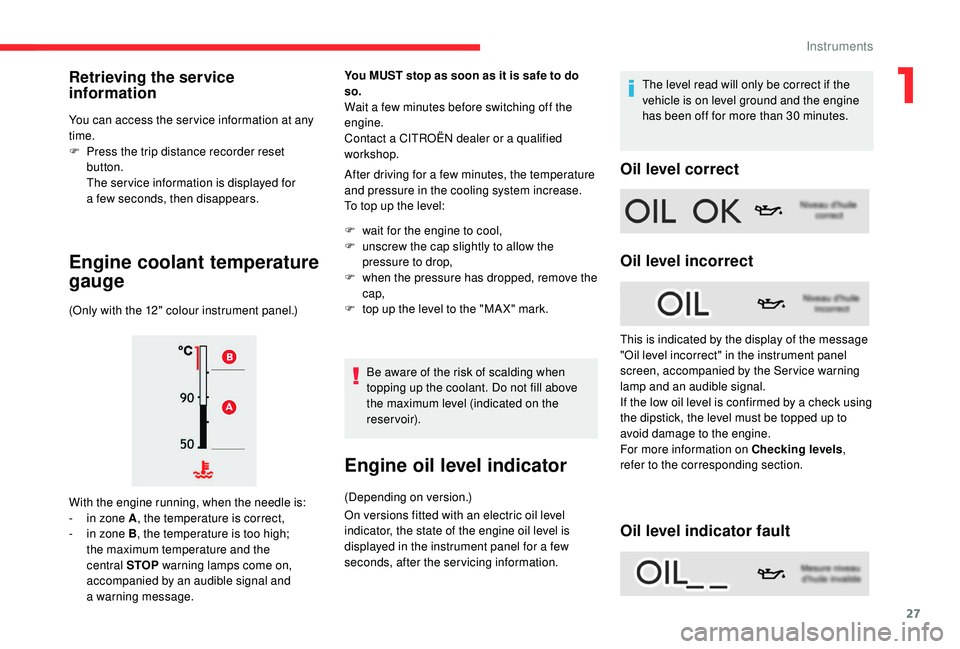
27
You can access the ser vice information at any
time.
F
P
ress the trip distance recorder reset
button.
The ser vice information is displayed for
a
few seconds, then disappears.
Engine coolant temperature
gauge
(Only with the 12" colour instrument panel.)
With the engine running, when the needle is:
-
i
n zone A , the temperature is correct,
-
i
n zone B , the temperature is too high;
the maximum temperature and the
central STOP warning lamps come on,
accompanied by an audible signal and
a
warning message.
You MUST stop as soon as it is safe to do
so.
Wait a few minutes before switching off the
e ngine.
Contact a
CITROËN dealer or a qualified
workshop.
After driving for a
few minutes, the temperature
and pressure in the cooling system increase.
To top up the level:
F
w
ait for the engine to cool,
F
u
nscrew the cap slightly to allow the
pressure to drop,
F
w
hen the pressure has dropped, remove the
cap,
F
t
op up the level to the "MA X" mark.Be aware of the risk of scalding when
topping up the coolant. Do not fill above
the maximum level (indicated on the
reservoir).
Engine oil level indicator
(Depending on version.)
On versions fitted with an electric oil level
indicator, the state of the engine oil level is
displayed in the instrument panel for a few
seconds, after the servicing information. The level read will only be correct if the
vehicle is on level ground and the engine
has been off for more than 30
minutes.
Oil level correct
Oil level incorrect
Oil level indicator fault
Retrieving the service
information
This is indicated by the display of the message
"Oil level incorrect" in the instrument panel
screen, accompanied by the Ser vice warning
lamp and an audible signal.
If the low oil level is confirmed by a
check using
the dipstick, the level must be topped up to
avoid damage to the engine.
For more information on Checking levels ,
refer to the corresponding section.
1
Instruments
Page 30 of 316

28
This is signalled by the display of the message "Oil
level measurement invalid" in the instrument panel.
Contact a CITROËN dealer or a qualified
workshop.
In the event of a fault with the electric
i ndicator, the engine oil level is no longer
monitored.
If the system is faulty, you must check the
engine oil level using the manual dipstick
located under the bonnet.
For more information on Checking levels ,
refer to the corresponding section.
AdBlue® range indicators
These range indicators are present only on
BlueHDi Diesel versions.
Once the AdBlue
® tank is on reser ve or after
detection of a
fault with the SCR emissions
control system, when the ignition is switched
on, an indicator displays an estimate of the
distance that can be covered, the range, before
engine starting is prevented.
In the event of the risk of non-
starting related to a lack of
AdBlue
®
The engine starting prevention system
required by regulations is activated
automatically once the AdBlue
® tank is
e m pt y.
Range greater than 1,500
miles (2,400 km)
When switching on the ignition, there is no
automatic display of range in the instrument
panel.
With the 12" colour instrument panel, pressing
this button temporarily displays the driving
range.
With access via the boot
Remaining range between 1,500 and
3 75 miles (2,400 and 600 km) When driving, the message is displayed every
185
miles (300 km) until the level is topped up.
The reser ve level has been reached; it is
recommended that you top up as soon as
possible.
When switching on the ignition, this warning
lamp comes on, accompanied by an audible
signal and the display of a message ("Top
up AdBlue: Starting impossible in x miles")
indicating the remaining range expressed in
miles or kilometres.
Remaining range less than 375 miles (600 km)
When switching on the ignition, this warning
lamp flashes, accompanied by the permanent
lighting of the Ser vice warning lamp, an audible
signal and the display of a
message ("Top
up AdBlue: Starting impossible in x miles")
indicating the remaining range in miles or
kilometres.
When driving, this message is displayed every
30
seconds until the AdBlue level has been
topped up.
It is essential to top up as soon as possible and
before the tank is completely empty; other wise
it will not be possible to restart the engine after
the next stop.
Breakdown related to a
lack of AdBlue
®
When switching on the ignition, this warning lamp
flashes, and the Ser vice warning lamp comes on,
accompanied by an audible signal and the display of
the message "Top up AdBlue: Starting impossible".
Instruments
Page 32 of 316
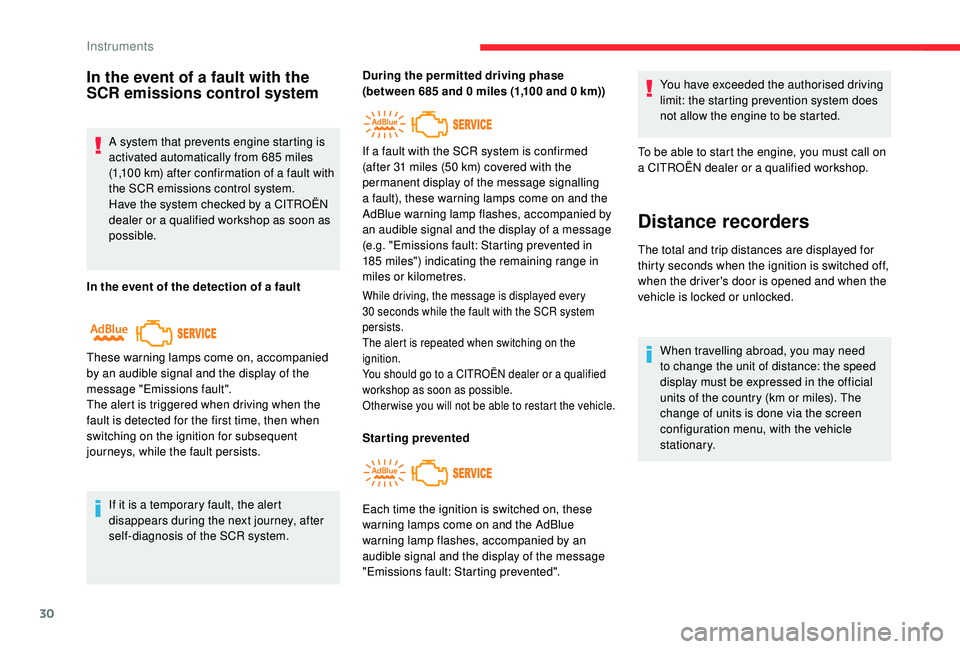
30
In the event of a fault with the
S CR emissions control system
A system that prevents engine starting is
activated automatically from 685
miles
(1,100
km) after confirmation of a fault with
the SCR emissions control system.
Have the system checked by a
CITROËN
dealer or a
qualified workshop as soon as
possible.
In the event of the detection of a
fault
If it is a
temporary fault, the alert
disappears during the next journey, after
self-diagnosis of the SCR system. During the permitted driving phase
(between 685
and 0 miles (1,100 and 0 km))
While driving, the message is displayed every
30
seconds while the fault with the SCR system
persists.
The alert is repeated when switching on the
ignition.
You should go to a
CITROËN dealer or a qualified
workshop as soon as possible.
Other wise you will not be able to restart the vehicle.
Starting prevented You have exceeded the authorised driving
limit: the starting prevention system does
not allow the engine to be started.
These warning lamps come on, accompanied
by an audible signal and the display of the
message "Emissions fault".
The alert is triggered when driving when the
fault is detected for the first time, then when
switching on the ignition for subsequent
journeys, while the fault persists. If a
fault with the SCR system is confirmed
(after 31 miles (50 km) covered with the
permanent display of the message signalling
a fault), these warning lamps come on and the
AdBlue warning lamp flashes, accompanied by
an audible signal and the display of a message
(e.g. "Emissions fault: Starting prevented in
185 miles") indicating the remaining range in
miles or kilometres.
Each time the ignition is switched on, these
warning lamps come on and the AdBlue
warning lamp flashes, accompanied by an
audible signal and the display of the message
"Emissions fault: Starting prevented". To be able to start the engine, you must call on
a
CITROËN dealer or a qualified workshop.
Distance recorders
The total and trip distances are displayed for
thirty seconds when the ignition is switched off,
when the driver's door is opened and when the
vehicle is locked or unlocked.
When travelling abroad, you may need
to change the unit of distance: the speed
display must be expressed in the official
units of the country (km or miles). The
change of units is done via the screen
configuration menu, with the vehicle
stationary.
Instruments
Page 46 of 316
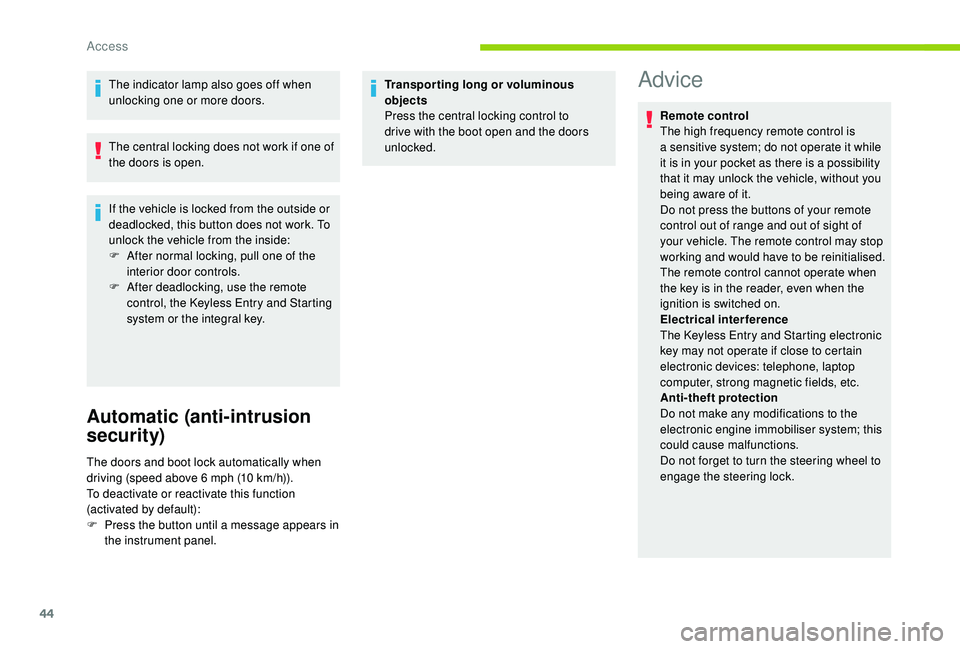
44
The indicator lamp also goes off when
unlocking one or more doors.
The central locking does not work if one of
the doors is open.
If the vehicle is locked from the outside or
deadlocked, this button does not work. To
unlock the vehicle from the inside:
F
A
fter normal locking, pull one of the
interior door controls.
F
A
fter deadlocking, use the remote
control, the Keyless Entry and Starting
system or the integral key.
Automatic (anti-intrusion
security)
The doors and boot lock automatically when
driving (speed above 6 mph (10 km/h)).
To deactivate or reactivate this function
(activated by default):
F
P
ress the button until a message appears in
the instrument panel. Transporting long or voluminous
objects
Press the central locking control to
drive with the boot open and the doors
unlocked.
Advice
Remote control
The high frequency remote control is
a
sensitive system; do not operate it while
it is in your pocket as there is a
possibility
that it may unlock the vehicle, without you
being aware of it.
Do not press the buttons of your remote
control out of range and out of sight of
your vehicle. The remote control may stop
working and would have to be reinitialised.
The remote control cannot operate when
the key is in the reader, even when the
ignition is switched on.
Electrical interference
The
K
eyless Entry and Starting electronic
key may not operate if close to certain
electronic devices: telephone, laptop
computer, strong magnetic fields, etc.
Anti-theft protection
Do not make any modifications to the
electronic engine immobiliser system; this
could cause malfunctions.
Do not forget to turn the steering wheel to
engage the steering lock.
Access
Page 77 of 316
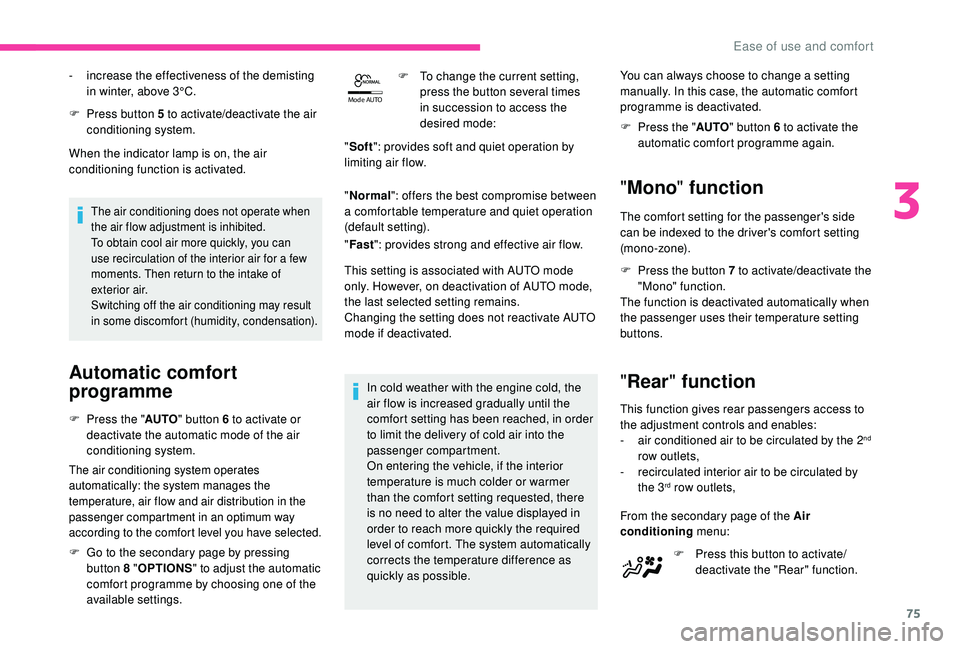
75
Mode AUTO
F Press button 5 to activate/deactivate the air
conditioning system.
When the indicator lamp is on, the air
conditioning function is activated.
The air conditioning does not operate when
the air flow adjustment is inhibited.
To obtain cool air more quickly, you can
use recirculation of the interior air for a
few
moments. Then return to the intake of
exterior air.
Switching off the air conditioning may result
in some discomfort (humidity, condensation).
Automatic comfort
programme
F Press the " AUTO" button 6 to activate or
deactivate the automatic mode of the air
conditioning system.
The air conditioning system operates
automatically: the system manages the
temperature, air flow and air distribution in the
passenger compartment in an optimum way
according to the comfort level you have selected.
F Go to the secondary page by pressing button 8 " OPTIONS " to adjust the automatic
comfort programme by choosing one of the
available settings. F
T
o change the current setting,
press the button several times
in succession to access the
desired mode:
" Soft ": provides soft and quiet operation by
limiting air flow.
" Normal ": offers the best compromise between
a
comfortable temperature and quiet operation
(default setting).
" Fast ": provides strong and effective air flow.
This setting is associated with AUTO mode
only. However, on deactivation of AUTO mode,
the last selected setting remains.
Changing the setting does not reactivate AUTO
mode if deactivated.
In cold weather with the engine cold, the
air flow is increased gradually until the
comfort setting has been reached, in order
to limit the delivery of cold air into the
passenger compartment.
On entering the vehicle, if the interior
temperature is much colder or warmer
than the comfort setting requested, there
is no need to alter the value displayed in
order to reach more quickly the required
level of comfort. The system automatically
corrects the temperature difference as
quickly as possible. You can always choose to change a
setting
manually. In this case, the automatic comfort
programme is deactivated.
F
P
ress the "
AUTO" button 6 to activate the
automatic comfort programme again.
" Mono " function
The comfort setting for the passenger's side
can be indexed to the driver's comfort setting
(mono-zone).
F
P
ress the button 7 to activate/deactivate the
"Mono" function.
The function is deactivated automatically when
the passenger uses their temperature setting
buttons.
" Rear " function
This function gives rear passengers access to
the adjustment controls and enables:
-
a
ir conditioned air to be circulated by the 2
nd
row outlets,
-
r
ecirculated interior air to be circulated by
the 3
rd row outlets,
-
i
ncrease the effectiveness of the demisting
in winter, above 3°C.
From the secondary page of the Air
conditioning menu:
F
P
ress this button to activate/
deactivate the "Rear" function.
3
Ease of use and comfort
Page 83 of 316

81
AC 230V
50Hz120W
Putting the portable console
back in place
Central storage 230 V/50 Hz socket
Connect only one device at a time to
t he socket (no extension or multi-way
connector).
Connect only devices with class II
insulation (shown on the device).
Do not use a
device with a metal case
(electric shaver,etc.).
As a
safety measure, when electrical
consumption is high and when required by
the vehicle's electrical system (particular
weather conditions, electrical overload,
etc.), the current supply to the socket will be
cut off; the green indicator lamp goes off.
12 V socket
F To connect a 12 V accessory (max. power:
120 W), lift the cover and connect a suitable
adaptor.
Do not exceed the maximum power rating
of the socket (other wise this could cause
damage to your portable device).
F
Pe
r form the steps in reversed order. Check
that the console is properly locked.
F
P
ull the handle and lower the lid to open the
central storage.
It is illuminated when opened. Deactivate the lighting by pressing the button
at the top.
Depending on equipment, this may include:
-
1
x 230
V socket,
-
1
x 12
V socket,
-
1
x USB port,
-
1
x JACK socket.
A 230
V/50
Hz socket (max. power: 120
W) is
fitted in the central storage.
To use the socket:
F
ope
n the central storage,
F
c
heck that the indicator lamp is on green,
F
c
onnect your multimedia or other electrical
device (telephone charger, laptop computer,
CD-DVD player, baby food warmer, etc.).
This socket works with the engine running, as
well as in STOP mode with Stop & Start.
In the event of a
fault with the socket, the green
indicator lamp flashes.
Have it checked by a
CITROËN dealer or
a
qualified workshop.
3
Ease of use and comfort
Page 106 of 316

104
Definitions
Anti-lock braking system (ABS)
and electronic brake force
distribution (EBFD)
These systems improve the stability and
manoeuvrability of your vehicle when braking
and contribute towards improved control in
corners, in particular on poor or slippery road
surfaces.
The ABS prevents wheel lock in the event of
emergency braking.
The EBFD system manages the braking
pressure wheel by wheel.
Emergency braking assistance
(EBA)
In an emergency, this system enables you to
reach the optimum braking pressure more
quickly and therefore reduce the stopping
distance.
It is triggered in relation to the speed at which
the brake pedal is pressed. This is felt by
a reduction in the resistance of the pedal and
an increase in the effectiveness of the braking.
Anti-slip regulation (ASR)
This system (also known as Traction Control)
optimises traction in order to limit wheel slip by
acting on the brakes of the driving wheels and
on the engine. It also improves the directional
stability of the vehicle on acceleration.
Dynamic stability control (DSC)
If there is a difference between the path
f ollowed by the vehicle and that required by
the driver, the DSC monitors each wheel and
automatically acts on the brake of one or more
wheels and on the engine to return the vehicle
to the required path, within the limits of the laws
of physics.
Intelligent traction control
( " Snow motion ")
Depending on version, your vehicle has
a
system to help driving on snow: intelligent
traction control.
This system detects situations of poor sur face
grip that could make it difficult to move off
or make progress on deep fresh snow or
compacted snow.
In these situations, the intelligent traction
control limits the amount of wheel spin to
provide the best traction and trajectory control
for your vehicle.
The use of snow tyres is strongly
recommended on sur faces offering low
levels of grip.
Anti-lock braking system
(ABS) and electronic brake
force distribution (EBFD)
When lit up continuously, this
warning lamp indicates a fault with
the ABS.
If this warning lamp comes on, in
conjunction with the STOP and ABS
warning lamps, an audible signal
and a
message, it means that the
electronic brake force distribution
(EBFD) is defective.
The vehicle retains conventional braking. Drive
carefully at moderate speed.
You must stop the vehicle as soon as it is
safe to do so.
In both cases, have the system checked by
a
CITROËN dealer or a qualified workshop as
soon as possible.
When changing wheels (tyres and rims),
ensure that these are approved for your
vehicle.
When operating under normal conditions,
the ABS may cause the brake pedal to
vibrate slightly.
Safety
Page 107 of 316
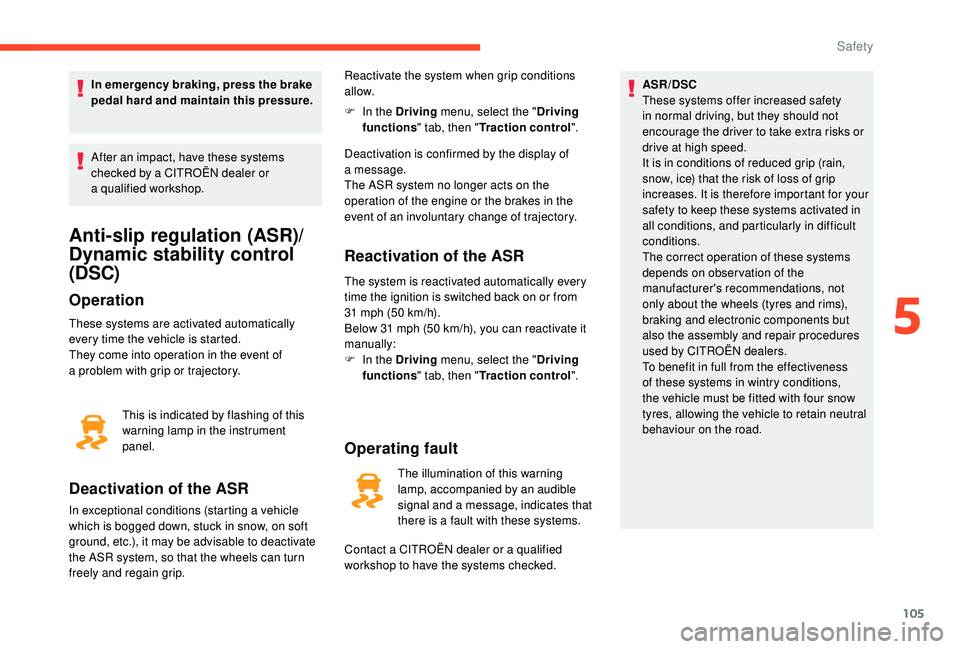
105
In emergency braking, press the brake
pedal hard and maintain this pressure.
After an impact, have these systems
checked by a CITROËN dealer or
a
qualified workshop.
Anti-slip regulation (ASR)/
Dynamic stability control
(DSC)
Operation
These systems are activated automatically
every time the vehicle is started.
They come into operation in the event of
a problem with grip or trajectory.
Deactivation of the ASR
In exceptional conditions (starting a vehicle
w hich is bogged down, stuck in snow, on soft
ground, etc.), it may be advisable to deactivate
the ASR system, so that the wheels can turn
freely and regain grip. F
I
n the Driving
menu, select the " Driving
functions " tab, then " Traction control".
Deactivation is confirmed by the display of
a
message.
The ASR system no longer acts on the
operation of the engine or the brakes in the
event of an involuntary change of trajectory.
Reactivation of the ASR
The system is reactivated automatically every
time the ignition is switched back on or from
31
mph (50 km/h).
Below 31
mph (50 km/h), you can reactivate it
manually:
F
I
n the Driving menu, select the " Driving
functions " tab, then " Traction control".
Operating fault
The illumination of this warning
lamp, accompanied by an audible
signal and a
message, indicates that
there is a
fault with these systems. ASR/DSC
These systems offer increased safety
in normal driving, but they should not
encourage the driver to take extra risks or
drive at high speed.
It is in conditions of reduced grip (rain,
snow, ice) that the risk of loss of grip
increases. It is therefore important for your
safety to keep these systems activated in
all conditions, and particularly in difficult
conditions.
The correct operation of these systems
depends on observation of the
manufacturer's recommendations, not
only about the wheels (tyres and rims),
braking and electronic components but
also the assembly and repair procedures
used by CITROËN dealers.
To benefit in full from the effectiveness
of these systems in wintry conditions,
the vehicle must be fitted with four snow
tyres, allowing the vehicle to retain neutral
behaviour on the road.
This is indicated by flashing of this
warning lamp in the instrument
panel. Reactivate the system when grip conditions
allow.
Contact a
CITROËN dealer or a qualified
workshop to have the systems checked.
5
Safety
Page 132 of 316

130
F With the electronic key inside the vehicle, press the " START/STOP " button.
The engine stops and the steering column
locks.
In some circumstances, it is necessary to turn
the steering wheel to lock the steering column.
On certain versions with the automatic gearbox
(EAT6/EAT8), the steering column does not
lock, but the gearbox locks in mode P .
If the vehicle is not immobilised, the
engine will not stop.
Never leave your vehicle with the
electronic key still inside.
Switching off the engine leads to a
loss of
braking assistance.
Key not detected
Back-up starting
When the electronic key is in the recognition
zone and after pressing the "START/STOP"
button, the engine does not start:
F
P
lace the gear selector at P or N for
vehicles with an automatic gearbox or
neutral for vehicles with a
manual gearbox.
F
P
lace the electronic key in the back-up
reader.
F
P
ress the brake pedal on vehicles with an
automatic gearbox, or fully depress the
clutch pedal with a
manual gearbox.
F
P
ress the "START/STOP" button.
The engine starts.
F
W
ith an automatic gearbox
, preferably
select mode P or N .
Back-up switch-off
F To confirm the instruction to switch off the
engine, press the " START/STOP" button for
about three seconds.
In the event of a
fault with the electronic key,
contact a
CITROËN dealer or a qualified
workshop.
Emergency switch-off
In the event of an emergency only, the engine
can be switched off without conditions (even
when driving).
Press the " START/STOP " button for about
three seconds.
In this case, the steering column locks as soon
as the vehicle stops. When the electronic key is not detected or is
no longer in the recognition zone, a message
appears in the instrument panel when closing
a door or trying to switch off the engine.
Driving
Page 133 of 316
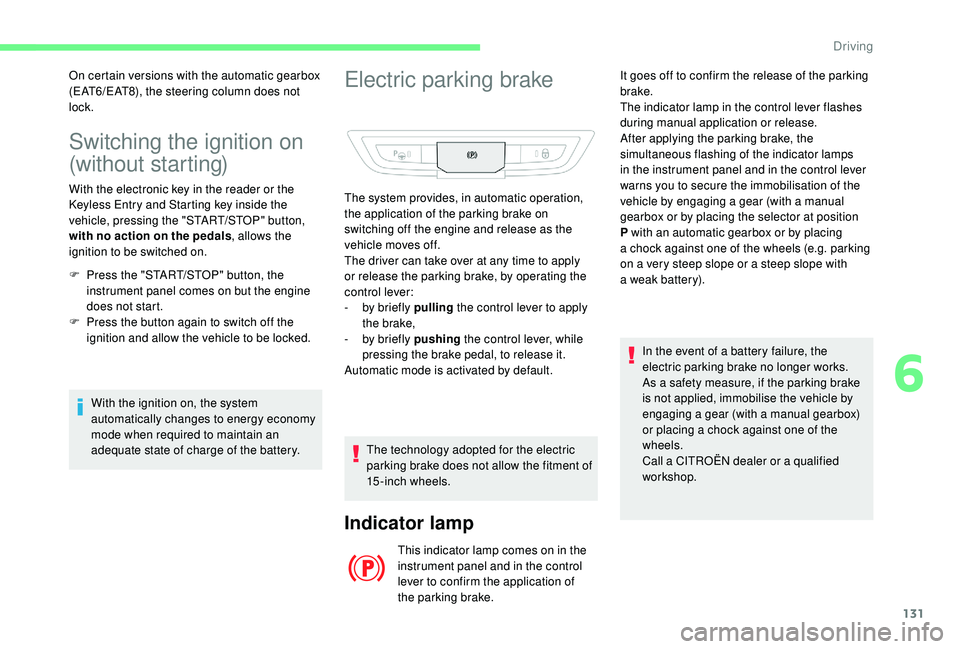
131
Switching the ignition on
(without starting)
With the electronic key in the reader or the
Keyless Entry and Starting key inside the
vehicle, pressing the "START/STOP" button,
with no action on the pedals, allows the
ignition to be switched on.
F
P
ress the "START/STOP" button, the
instrument panel comes on but the engine
does not start.
F
P
ress the button again to switch off the
ignition and allow the vehicle to be locked.
With the ignition on, the system
automatically changes to energy economy
mode when required to maintain an
adequate state of charge of the battery.
On certain versions with the automatic gearbox
(EAT6/EAT8), the steering column does not
lock.
Electric parking brake
The technology adopted for the electric
parking brake does not allow the fitment of
15-inch wheels.
Indicator lamp
This indicator lamp comes on in the
instrument panel and in the control
lever to confirm the application of
the parking brake. It goes off to confirm the release of the parking
brake.
The indicator lamp in the control lever flashes
during manual application or release.
After applying the parking brake, the
simultaneous flashing of the indicator lamps
in the instrument panel and in the control lever
warns you to secure the immobilisation of the
vehicle by engaging a
gear (with a manual
gearbox or by placing the selector at position
P with an automatic gearbox or by placing
a chock against one of the wheels (e.g. parking
on a very steep slope or a steep slope with
a weak battery).
In the event of a battery failure, the
electric parking brake no longer works.
As a safety measure, if the parking brake
is not applied, immobilise the vehicle by
engaging a
gear (with a
manual gearbox)
or placing a chock against one of the
wheels.
Call a CITROËN dealer or a qualified
workshop.
The system provides, in automatic operation,
the application of the parking brake on
switching off the engine and release as the
vehicle moves off.
The driver can take over at any time to apply
or release the parking brake, by operating the
control lever:
-
b
y briefly pulling
the control lever to apply
the brake,
-
b
y briefly pushing
the control lever, while
pressing the brake pedal, to release it.
Automatic mode is activated by default.
6
Driving